From Triboelectric Nanogenerator to Polymer-Based Biosensor: A Review
Abstract
:1. Introduction
2. TENG as Wearable Biosensors for Health Monitoring
2.1. Body Condition Monitoring
2.2. Cardiology Sensors
2.3. Pneumology Sensors

2.4. Motion Sensors
2.4.1. Foot and Leg Motions
2.4.2. Arm Motion
2.4.3. Hand Movement
2.4.4. Muscle Stretching
3. TENG as Implantable Biosensors
3.1. Cardiology Sensors
3.2. Pneumology Sensors
3.3. Other Implantable Biomedical Sensors
4. TENG as Power Sources for Biosensors
4.1. Heart Rate Monitoring
4.2. Body Condition Monitoring
4.3. Drug Delivery
5. Conclusions and Perspectives
5.1. Power Output Enhancement
5.2. Durability and Stability
5.3. Multifunctionality
5.4. Comfortability
Author Contributions
Funding
Institutional Review Board Statement
Informed Consent Statement
Data Availability Statement
Conflicts of Interest
References
- Ma, J.M.; Zhu, J.Q.; Ma, P.; Jie, Y.; Wang, Z.L.; Cao, X. Fish Bladder Film-Based Triboelectric Nanogenerator for Noncontact Position Monitoring. ACS Energy Lett. 2020, 5, 3005–3011. [Google Scholar] [CrossRef]
- Wang, Z.W.; Luan, C.C.; Zhu, Y.B.; Liao, G.X.; Liu, J.P.; Li, X.J.; Yao, X.H.; Fu, J.Z. Integrated and shape-adaptable multifunctional flexible triboelectric nanogenerators using coaxial direct ink writing 3D printing. Nano Energy 2021, 90, 106534. [Google Scholar] [CrossRef]
- Xiong, J.Q.; Cui, P.; Chen, X.L.; Wang, J.X.; Parida, K.; Lin, M.F.; Lee, P.S. Skin-touch-actuated textile-based triboelectric nanogenerator with black phosphorus for durable biomechanical energy harvesting. Nat. Commun. 2018, 9, 4280. [Google Scholar] [CrossRef] [PubMed] [Green Version]
- Fan, W.J.; He, Q.; Meng, K.Y.; Tan, X.L.; Zhou, Z.H.; Zhang, G.Q.; Yang, J.; Wang, Z.L. Machine-knitted washable sensor array textile for precise epidermal physiological signal monitoring. Sci. Adv. 2020, 6, 2840. [Google Scholar] [CrossRef] [Green Version]
- Sheng, F.F.; Yi, J.; Shen, S.; Cheng, R.W.; Ning, C.; Ma, L.Y.; Peng, X.; Deng, W.; Dong, K.; Wang, Z.L. Self-powered smart arm training band sensor based on extremely stretchable hydrogel conductors. ACS Appl. Mater. Interfaces 2021, 13, 44868–44877. [Google Scholar] [CrossRef]
- Shrestha, K.; Sharma, S.; Pradhan, G.B.; Bhatta, T.; Maharjan, P.; Rana, S.M.S.; Lee, S.; Seonu, S.; Shin, Y.; Park, J.Y. A siloxene/Ecoflex nanocomposite-based triboelectric nanogenerator with enhanced charge retention by MoS2/LIG for self-powered touchless sensor applications. Adv. Funct. Mater. 2022, 2113005. [Google Scholar] [CrossRef]
- Dos Santos, C.C.; Lucena, G.N.; Pinto, G.C.; Júnior, M.J.; Marques, R.F.C. Advances and current challenges in non-invasive wearable sensors and wearable biosensors—A mini-review. Med. Devices Sens. 2020, 4, e10130. [Google Scholar] [CrossRef]
- Sim, D.; Brothers, M.C.; Slocik, J.M.; Islam, A.E.; Maruyama, B.; Grigsby, C.C.; Naik, R.R.; Kim, S.S. Biomarkers and detection Platforms for human health and performance monitoring: A Review. Adv. Sci. 2022, 9, 2104426. [Google Scholar] [CrossRef]
- Xia, X.; Liu, Q.; Zhu, Y.; Zi, Y. Recent advances of triboelectric nanogenerator based applications in biomedical systems. EcoMat 2020, 2, e12049. [Google Scholar] [CrossRef]
- Li, T.; Li, Y.; Zhang, T. Materials, Structures, and Functions for Flexible and Stretchable Biomimetic Sensors. Acc. Chem. Res. 2019, 52, 288–296. [Google Scholar] [CrossRef]
- Zhang, S.L.; Bick, M.; Xiao, X.; Chen, G.R.; Nashalian, A.; Chen, J. Leveraging triboelectric nanogenerators for bioengineering. Matter 2021, 4, 845–887. [Google Scholar] [CrossRef]
- Lei, D.; Yang, Y.; Liu, Z.H.; Yang, B.Q.; Gong, W.H.; Chen, S.; Wang, S.F.; Sun, L.J.; Song, B.Y.; Xuan, H.X.; et al. 3D printing of biomimetic vasculature for tissue regeneration. Mater. Horiz. 2019, 6, 1197–1206. [Google Scholar] [CrossRef]
- Long, Y.; Wei, H.; Li, J.; Yao, G.; Yu, B.; Ni, D.L.; Gibson, A.L.; Lan, X.L.; Jiang, Y.D.; Cai, W.B.; et al. Effective wound healing enabled by discrete alternative electric fields from wearable nanogenerators. ACS Nano 2018, 12, 12533–12540. [Google Scholar] [CrossRef] [PubMed] [Green Version]
- Yao, G.; Jiang, D.W.; Li, J.; Kang, L.; Chen, S.H.; Long, Y.; Wang, Y.Z.; Huang, P.; Lin, Y.; Cai, W.B.; et al. Self-activated electrical stimulation for effective hair regeneration via a wearable omnidirectional pulse generator. ACS Nano 2019, 13, 12345–12356. [Google Scholar] [CrossRef] [PubMed]
- Ouyang, H.; Tian, J.J.; Sun, G.L.; Zou, Y.; Liu, Z.; Li, H.; Zhao, L.M.; Shi, B.J.; Fan, Y.B.; Fan, Y.F.; et al. Self-powered pulse sensor for antidiastole of cardiovascular disease. Adv. Mater. 2017, 29, 1703456. [Google Scholar] [CrossRef] [PubMed]
- Lee, S.; Wang, H.; Wang, J.H.; Shi, Q.F.; Yen, S.C.; Thakor, N.V.; Lee, C.K. Battery-free neuromodulator for peripheral nerve direct stimulation. Nano Energy 2018, 50, 148–158. [Google Scholar] [CrossRef]
- Tat, T.; Libanori, A.; Au, C.; Yau, A.; Chen, J. Advances in triboelectric nanogenerators for biomedical sensing. Biosens. Bioelectron. 2021, 171, 112714. [Google Scholar] [CrossRef]
- Jiang, W.; Li, H.; Liu, Z.; Li, Z.; Tian, J.J.; Shi, B.J.; Zou, Y.; Ouyang, H.; Zhao, C.C.; Zhao, L.M.; et al. Fully bioabsorbable natural-materials-based triboelectric nanogenerators. Adv. Mater. 2018, 30, 1801895. [Google Scholar] [CrossRef]
- Tian, J.J.; Shi, R.; Liu, Z.; Ouyang, H.; Yu, M.; Zhao, C.C.; Zou, Y.; Jiang, D.J.; Zhang, J.S.; Li, Z. Self-powered implantable electrical stimulator for osteoblasts’ proliferation and differentiation. Nano Energy 2019, 59, 705–714. [Google Scholar] [CrossRef]
- Basatneh, R.; Najafi, B.; Armstrong, D.G. Health sensors, smart home devices, and the internet of medical things: An opportunity for dramatic improvement in care for the lower extremity complications of diabetes. J. Diabetes Sci. Technol. 2018, 12, 577–586. [Google Scholar] [CrossRef]
- Zou, Y.J.; Raveendran, V.; Chen, J. Wearable triboelectric nanogenerators for biomechanical energy harvesting. Nano Energy 2020, 77, 105303. [Google Scholar] [CrossRef]
- Seyedin, S.; Uzun, S.; Levitt, A.; Anasori, B.; Dion, G.; Gogotsi, Y.; Razal, J.M. MXene composite and coaxial fibers with high stretchability and conductivity for wearable strain sensing textiles. Adv. Funct. Mater. 2020, 30, 1910504. [Google Scholar] [CrossRef]
- Noh, K.N.; Park, S.I.; Qazi, R.; Zou, Z.; Mickle, A.D.; Grajales-Reyes, J.G.; Jang, K.I.; Gereau, R.W.T.; Xiao, J.; Rogers, J.A.; et al. Miniaturized, battery-free optofluidic systems with potential for wireless pharmacology and optogenetics. Small 2018, 14, 1702479. [Google Scholar] [CrossRef] [PubMed]
- Zheng, Q.; Tang, Q.Z.; Wang, Z.L.; Li, Z. Self-powered cardiovascular electronic devices and systems. Nat. Rev. Cardiol. 2021, 18, 7–21. [Google Scholar] [CrossRef] [PubMed]
- Abir, S.S.H.; Sadaf, M.U.K.; Saha, S.K.; Touhami, A.; Lozano, K.; Uddin, M.J. Nanofiber-based substrate for a triboelectric nanogenerator: High-Performance flexible energy fiber mats. ACS Appl. Mater. Interfaces 2021, 13, 60401–60412. [Google Scholar] [CrossRef] [PubMed]
- Dong, K.; Wu, Z.Y.; Deng, J.N.; Wang, A.C.; Zou, H.Y.; Chen, C.Y.; Hu, D.M.; Gu, B.H.; Sun, B.Z.; Wang, Z.L. A stretchable yarn embedded triboelectric nanogenerator as electronic skin for biomechanical energy harvesting and multifunctional pressure sensing. Adv. Mater. 2018, 30, 1804944. [Google Scholar] [CrossRef]
- Yu, Z.H.; Wu, P.Y. Underwater communication and optical camouflage Ionogels. Adv. Mater. 2021, 33, 2008479. [Google Scholar] [CrossRef]
- Wu, Z.P.; Chen, J.; Boukhvalov, D.W.; Luo, Z.Y.; Zhu, L.J.; Shi, Y.J. A new triboelectric nanogenerator with excellent electric breakdown self-healing performance. Nano Energy 2021, 85, 105990. [Google Scholar] [CrossRef]
- Sun, J.; Ahn, D.; Kim, J.; Ahn, S.; Hwang, J.S.; Kwon, J.Y.; Lee, J.S.; Oh, J.M.; Nam, K.; Park, J.-J. Surface-control enhanced crater-like electrode in a gelatin/polyvinyl alcohol/carbon composite for biodegradable multi-modal sensing systems with human-affinity. J. Mater. Chem. A 2021, 9, 9145–9156. [Google Scholar] [CrossRef]
- Wang, J.Q.; Shi, J.H.; Deng, X.L.; Xie, L.J.; Jiang, J.X.; Tang, J.Q.; Liu, J.F.; Wen, Z.; Sun, X.H.; Liu, K.Q.; et al. Transition metal pincer complex based self-healable, stretchable and transparent triboelecctric nanogenerator. Nano Energy 2020, 78, 105348. [Google Scholar] [CrossRef]
- Andrew, T.L. The future of smart textiles: User interfaces and health monitors. Matter 2020, 2, 794–795. [Google Scholar] [CrossRef]
- Parida, K.; Xiong, J.; Zhou, X.; Lee, P.S. Progress on triboelectric nanogenerator with stretchability, self-healability and bio-compatibility. Nano Energy 2019, 59, 237–257. [Google Scholar] [CrossRef]
- Chortos, A.; Liu, J.; Bao, Z. Pursuing prosthetic electronic skin. Nat. Mater. 2016, 15, 937–950. [Google Scholar] [CrossRef] [PubMed]
- Zhou, Z.H.; Li, X.S.; Wu, Y.F.; Zhang, H.; Lin, Z.W.; Meng, K.Y.; Lin, Z.M.; He, Q.; Sun, C.C.; Yang, J.; et al. Wireless self-powered sensor networks driven by triboelectric nanogenerator for in-situ real time survey of environmental monitoring. Nano Energy 2018, 53, 501–507. [Google Scholar] [CrossRef]
- Yu, J.B.; Hou, X.J.; He, J.; Cui, M.; Wang, C.; Geng, W.P.; Mu, J.L.; Han, B.; Chou, X.J. Ultra-flexible and high-sensitive triboelectric nanogenerator as electronic skin for self-powered human physiological signal monitoring. Nano Energy 2020, 69, 104437. [Google Scholar] [CrossRef]
- Sun, Q.Z.; Wang, L.; Yue, X.P.; Zhang, L.R.; Ren, G.Z.; Li, D.H.; Wang, H.C.; Han, Y.J.; Xiao, L.L.; Lu, G.; et al. Fully sustainable and high-performance fish gelatin-based triboelectric nanogenerator for wearable movement sensing and human-machine interaction. Nano Energy 2021, 89, 106329. [Google Scholar] [CrossRef]
- Zhou, H.W.; Wang, Z.W.; Zhao, W.F.; Tong, X.M.; Jin, X.L.; Zhang, X.C.; Yu, Y.; Liu, H.B.; Ma, Y.C.; Li, S.S.; et al. Robust and sensitive pressure/strain sensors from solution processable composite hydrogels enhanced by hollow-structured conducting polymers. Chem. Eng. J. 2021, 403, 126307. [Google Scholar] [CrossRef]
- Liu, Y.Q.; He, K.; Chen, G.; Leow, W.R.; Chen, X.D. Nature-inspired structural materials for flexible electronic devices. Chem. Rev. 2017, 117, 12893–12941. [Google Scholar] [CrossRef]
- Wang, L.; Fu, X.M.; He, J.Q.; Shi, X.; Chen, T.Q.; Chen, P.N.; Wang, B.J.; Peng, H.S. Application challenges in fiber and textile flectronics. Adv. Mater. 2020, 32, 1901971. [Google Scholar] [CrossRef]
- Zeng, Y.M.; Xiang, H.J.; Zheng, N.; Cao, X.; Wang, N.; Wang, Z.L. Flexible triboelectric nanogenerator for human motion tracking and gesture recognition. Nano Energy 2021, 91, 106601. [Google Scholar] [CrossRef]
- Chen, G.R.; Li, Y.Z.; Bick, M.; Chen, J. Smart textiles for electricity generation. Chem. Rev. 2020, 120, 3668–3720. [Google Scholar] [CrossRef] [PubMed]
- Jia, Y.H.; Jiang, Q.L.; Sun, H.D.; Liu, P.P.; Hu, D.H.; Pei, Y.Z.; Liu, W.S.; Crispin, X.; Fabiano, S.; Ma, Y.G.; et al. Wearable thermoelectric materials and devices for self-powered electronic systems. Adv. Mater. 2021, 33, 2102990. [Google Scholar] [CrossRef] [PubMed]
- Luo, J.J.; Gao, W.C.; Wang, Z.L. The triboelectric nanogenerator as an innovative technology toward intelligent sports. Adv. Mater. 2021, 33, 2004178. [Google Scholar] [CrossRef] [PubMed]
- Ryu, H.; Yoon, H.J.; Kim, S.W. Hybrid energy harvesters: Toward sustainable energy harvesting. Adv. Mater. 2019, 31, 1802898. [Google Scholar] [CrossRef]
- Chen, L.J.; Chen, C.Y.; Jin, L.; Guo, H.Y.; Wang, A.C.; Ning, F.G.; Xu, Q.L.; Du, Z.Q.; Wang, F.M.; Wang, Z.L. Stretchable negative Poisson’s ratio yarn for triboelectric nanogenerator for environmental energy harvesting and self-powered sensor. Energy Environ. Sci. 2021, 14, 955–964. [Google Scholar] [CrossRef]
- Chen, J.; Guo, H.Y.; Pu, X.J.; Wang, X.; Xi, Y.; Hu, C.G. Traditional weaving craft for one-piece self-charging power textile for wearable electronics. Nano Energy 2018, 50, 536–543. [Google Scholar] [CrossRef]
- Zhou, Q.; Pan, J.; Deng, S.; Xia, F.; Kim, T. Triboelectric nanogenerator-based sensor systems for chemical or biological detection. Adv. Mater. 2021, 33, 2008276. [Google Scholar] [CrossRef]
- Ahmed, A.; Hassan, I.; El-Kady, M.F.; Radhi, A.; Jeong, C.K.; Selvaganapathy, P.R.; Zu, J.; Ren, S.; Wang, Q.; Kaner, R.B. Integrated triboelectric nanogenerators in the era of the internet of things. Adv. Sci. 2019, 6, 1802230. [Google Scholar] [CrossRef] [Green Version]
- Zhu, J.X.; Zhu, M.L.; Shi, Q.F.; Wen, F.; Liu, L.; Dong, B.W.; Haroun, A.; Yang, Y.Q.; Vachon, P.; Guo, X.; et al. Progress in TENG technology—A journey from energy harvesting to nanoenergy and nanosystem. EcoMat 2020, 2, 1–45. [Google Scholar] [CrossRef]
- Wang, L.Y.; Daoud, W.A. Highly flexible and transparent polyionic-skin triboelectric nanogenerator for biomechanical motion harvesting. Adv. Energy Mater. 2019, 9, 1803183. [Google Scholar] [CrossRef]
- Zhu, J.Q.; Cheng, Y.; Hao, S.F.; Wang, Z.L.; Wang, N.; Cao, X. A self-healing triboelectric nanogenerator based on feathers for sensing and energy harvesting. Adv. Funct. Mater. 2021, 31, 2100039. [Google Scholar] [CrossRef]
- Wang, Z.L. From contact electrification to triboelectric nanogenerators. Rep. Prog. Phys. 2021, 84, 096502. [Google Scholar] [CrossRef] [PubMed]
- Liu, W.; Wang, Z.; Wang, G.; Liu, G.L.; Chen, J.; Pu, X.J.; Xi, Y.; Wang, X.; Guo, H.Y.; Hu, C.G.; et al. Integrated charge excitation triboelectric nanogenerator. Nat. Commun. 2019, 10, 1426. [Google Scholar] [CrossRef] [PubMed] [Green Version]
- Xu, F.; Dong, S.S.; Liu, G.X.; Pan, C.X.; Guo, Z.H.; Guo, W.B.; Li, L.W.; Liu, Y.P.; Zhang, C.; Pu, X.; et al. Scalable fabrication of stretchable and washable textile triboelectric nanogenerators as constant power sources for wearable electronics. Nano Energy 2021, 88, 106247. [Google Scholar] [CrossRef]
- Dharmasena, R.D.I.G.; Jayawardena, K.D.G.I.; Mills, C.A.; Deane, J.H.B.; Anguita, J.V.; Dorey, R.A.; Silva, S.R.P. Triboelectric nanogenerators: Providing a fundamental framework. Energy Environ. Sci. 2017, 10, 1801–1811. [Google Scholar] [CrossRef]
- Rahman, M.T.; Rana, S.M.S.; Salauddin, M.; Maharjan, P.; Bhatta, T.; Park, J.Y. Biomechanical energy-driven hybridized generator as a universal portable power source for smart/wearable electronics. Adv. Energy Mater. 2020, 10, 1903663. [Google Scholar] [CrossRef]
- Li, S.Y.; Nie, J.H.; Shi, Y.X.; Tao, X.L.; Wang, F.; Tian, J.W.; Lin, S.Q.; Chen, X.Y.; Wang, Z.L. Contributions of different functional groups to contact electrification of polymers. Adv. Mater. 2020, 32, 2001307. [Google Scholar] [CrossRef]
- Ahmed, A.; Hassan, I.; Pourrahimi, A.M.; Helal, A.S.; El-Kady, M.F.; Khassaf, H.; Kaner, R.B. Toward high-performance triboelectric nanogenerators by engineering interfaces at the nanoscale: Looking into the future research roadmap. Adv. Mater. Technol. 2020, 5, 2000520. [Google Scholar] [CrossRef]
- Song, Y.D.; Wang, N.; Hu, C.S.; Wang, Z.L.; Yang, Y. Soft triboelectric nanogenerators for mechanical energy scavenging and self-powered sensors. Nano Energy 2021, 84, 105919. [Google Scholar] [CrossRef]
- He, F.L.; You, X.Y.; Gong, H.; Yang, Y.; Bai, T.; Wang, W.G.; Guo, W.X.; Liu, X.Y.; Ye, M.D. Stretchable, biocompatible, and multifunctional silk fibroin-based hydrogels toward wearable strain/pressure sensors and triboelectric nanogenerators. ACS Appl. Mater. Interfaces 2020, 12, 6442–6450. [Google Scholar] [CrossRef]
- Ahn, J.; Zhao, Z.J.; Choi, J.; Jeong, Y.; Hwang, S.; Ko, J.; Gu, J.; Jeon, S.; Park, J.; Kang, M.; et al. Morphology-controllable wrinkled hierarchical structure and its application to superhydrophobic triboelectric nanogenerator. Nano Energy 2021, 85, 105978. [Google Scholar] [CrossRef]
- Wang, H.B.; Han, M.D.; Song, Y.; Zhang, H.X. Design, manufacturing and applications of wearable triboelectric nanogenerators. Nano Energy 2021, 81, 105627. [Google Scholar] [CrossRef]
- Chen, K.J.; Zhang, L.; Kuang, X.; Li, V.; Lei, M.; Kang, G.Z.; Wang, Z.L.; Qi, H.J. Dynamic photomask-assisted direct ink writing multimaterial for multilevel triboelectric nanogenerator. Adv. Funct. Mater. 2019, 29, 1903568. [Google Scholar] [CrossRef]
- Li, H.L.; Xu, F.C.; Guan, T.T.; Li, Y.; Sun, J.Q. Mechanically and environmentally stable triboelectric nanogenerator based on high-strength and anti-compression self-healing ionogel. Nano Energy 2021, 90, 106645. [Google Scholar] [CrossRef]
- Wang, W.; Yu, A.F.; Liu, X.; Liu, Y.D.; Zhang, Y.; Zhu, Y.X.; Lei, Y.; Jia, M.M.; Zhai, J.Y.; Wang, Z.L. Large-scale fabrication of robust textile triboelectric nanogenerators. Nano Energy 2020, 71, 104605. [Google Scholar] [CrossRef]
- Xu, L.L.; Yang, Y.; Mao, Y.K.; Li, Z. Self-powerbility in electrical stimulation drug delivery system. Adv. Mater. Technol. 2021, 7, 2100055. [Google Scholar] [CrossRef]
- Liu, Y.Y.; Zhao, W.W.; Liu, G.X.; Bu, T.Z.; Xia, Y.C.; Xu, S.H.; Zhang, C.; Zhang, H.Y. Self-powered artificial joint wear debris sensor based on triboelectric nanogenerator. Nano Energy 2021, 85, 105967. [Google Scholar] [CrossRef]
- Hu, Y.; Shi, Y.D.; Cao, X.Y.; Liu, Y.P.; Guo, S.Y.; Shen, J.B. Enhanced output and wearable performances of triboelectric nanogenerator based on ePTFE microporous membranes for motion monitoring. Nano Energy 2021, 86, 106103. [Google Scholar] [CrossRef]
- Liu, R.; Kuang, X.; Deng, J.; Wang, Y.C.; Wang, A.C.; Ding, W.; Lai, Y.C.; Chen, J.; Wang, P.; Lin, Z.; et al. Shape memory polymers for body motion energy harvesting and self-powered mechanosensing. Adv. Mater. 2018, 30, 1705195. [Google Scholar] [CrossRef]
- Barkas, D.A.; Psomopoulos, C.S.; Papageorgas, P.; Kalkanis, K.; Piromalis, D.; Mouratidis, A. Sustainable energy harvesting through triboelectric nanogenerators: A Review of current status and applications assessing the feasibility of using the heat demand-outdoor. Energy Procedia 2019, 157, 999–1010. [Google Scholar] [CrossRef]
- Dong, K.; Wang, Y.C.; Deng, J.; Dai, Y.; Zhang, S.L.; Zou, H.; Gu, B.; Sun, B.; Wang, Z.L. A highly stretchable and washable all-yarn-based self-charging knitting power textile composed of fiber triboelectric nanogenerators and supercapacitors. ACS Nano 2017, 11, 9490–9499. [Google Scholar] [CrossRef] [PubMed]
- Jiang, Y.; Dong, K.; Li, X.; An, J.; Wu, D.Q.; Peng, X.; Yi, J.; Ning, C.; Cheng, R.W.; Yu, P.T.; et al. Stretchable, washable, and ultrathin triboelectric nanogenerators as skin-like highly sensitive self-powered haptic sensors. Adv. Funct. Mater. 2020, 31, 2005584. [Google Scholar] [CrossRef]
- Lin, Z.; Chen, J.; Li, X.; Zhou, Z.; Meng, K.; Wei, W.; Yang, J.; Wang, Z.L. Triboelectric nanogenerator enabled body sensor network for self-powered human heart-rate monitoring. ACS Nano 2017, 11, 8830–8837. [Google Scholar] [CrossRef] [PubMed]
- Lin, Z.W.; Sun, C.C.; Liu, W.C.; Fan, E.D.; Zhang, G.Q.; Tan, X.L.; Shen, Z.Y.; Qiu, J.; Yang, J. A self-powered and high-frequency vibration sensor with layer-powder-layer structure for structural health monitoring. Nano Energy 2021, 90, 106366. [Google Scholar] [CrossRef]
- Zhao, T.M.; Fu, Y.M.; Sun, C.X.; Zhao, X.S.; Jiao, C.X.; Du, A.; Wang, Q.; Mao, Y.P.; Liu, B.D. Wearable biosensors for real-time sweat analysis and body motion capture based on stretchable fiber-based triboelectric nanogenerators. Biosens. Bioelectron. 2022, 205, 114115. [Google Scholar] [CrossRef]
- Qin, Y.; Mo, J.L.; Liu, Y.H.; Zhang, S.; Wang, J.L.; Fu, Q.; Wang, S.F.; Nie, S.X. Stretchable triboelectric self-powered sweat sensor fabricated from self-healing nanocellulose hydrogels. Adv. Funct. Mater. 2022, 2201846. [Google Scholar] [CrossRef]
- Rao, J.H.; Chen, Z.T.; Zhao, D.N.; Ma, R.; Yi, W.Y.; Zhang, C.X.; Liu, D.; Chen, X.; Yang, Y.H.; Wang, X.F.; et al. Tactile electronic skin to simultaneously detect and distinguish between temperature and pressure based on a triboelectric nanogenerator. Nano Energy 2020, 75, 105073. [Google Scholar] [CrossRef]
- Meng, K.Y.; Chen, J.; Li, X.S.; Wu, Y.F.; Fan, W.J.; Zhou, Z.H.; He, Q.; Wang, X.; Fan, X.; Zhang, Y.X.; et al. Flexible weaving constructed self-powered pressure sensor enabling continuous diagnosis of cardiovascular disease and measurement of cuffless blood pressure. Adv. Funct. Mater. 2019, 29, 1806388. [Google Scholar] [CrossRef]
- Lou, M.N.; Abdalla, I.; Zhu, M.M.; Yu, J.Y.; Li, Z.L.; Ding, B. Hierarchically rough structured and self-powered pressure sensor textile for motion sensing and pulse monitoring. ACS Appl. Mater. Interfaces 2020, 12, 1597–1605. [Google Scholar] [CrossRef]
- Wang, R.X.; Mu, L.W.; Bao, Y.K.; Lin, H.; Ji, T.; Shi, Y.J.; Zhu, J.H.; Wu, W.Z. Holistically engineered polymer-polymer and polymer-ion interactions in biocompatible polyvinyl alcohol blends for high-performance triboelectric devices in self-powered wearable cardiovascular monitorings. Adv. Mater. 2020, 32, 2002878. [Google Scholar] [CrossRef]
- Xu, L.X.; Zhang, Z.; Gao, F.F.; Zhao, X.; Xun, X.C.; Kang, Z.; Liao, Q.L.; Zhang, Y. Self-powered ultrasensitive pulse sensors for noninvasive multi-indicators cardiovascular monitoring. Nano Energy 2021, 81, 105614. [Google Scholar] [CrossRef]
- Ding, X.; Cao, H.; Zhang, X.; Li, M.; Liu, Y. Large scale triboelectric nanogenerator and self-powered flexible sensor for human sleep monitoring. Sensors 2018, 18, 1713. [Google Scholar] [CrossRef] [PubMed] [Green Version]
- Meng, K.Y.; Zhao, S.L.; Zhou, Y.H.; Wu, Y.F.; Zhang, S.L.; He, Q.; Wang, X.; Zhou, Z.H.; Fan, W.J.; Tan, X.L.; et al. A wireless textile-based sensor system for self-powered personalized health care. Matter 2020, 2, 896–907. [Google Scholar] [CrossRef]
- Chen, S.W.; Wu, N.; Ma, L.; Lin, S.Z.; Yuan, F.; Xu, Z.S.; Li, W.B.; Wang, B.; Zhou, J. Noncontact heartbeat and respiration monitoring based on a hollow microstructured self-powered pressure sensor. ACS Appl. Mater. Interfaces 2018, 10, 3660–3667. [Google Scholar] [CrossRef]
- Shin, Y.E.; Lee, J.E.; Park, Y.; Hwang, S.H.; Chae, H.G.; Ko, H. Sewing machine stitching of polyvinylidene fluoride fibers: Programmable textile patterns for wearable triboelectric sensors. J. Mater. Chem. A 2018, 6, 22879–22888. [Google Scholar] [CrossRef]
- Lu, Q.; Chen, H.; Zeng, Y.; Xue, J.; Cao, X.; Wang, N.; Wang, Z. Intelligent facemask based on triboelectric nanogenerator for respiratory monitoring. Nano Energy 2022, 91, 106612. [Google Scholar] [CrossRef]
- He, H.; Guo, J.; Illés, B.; Géczy, A.; Istók, B.; Hliva, V.; Török, D.; Kovács, J.G.; Harmati, I.; Molnár, K. Monitoring multi-respiratory indices via a smart nanofibrous mask filter based on a triboelectric nanogenerator. Nano Energy 2021, 89, 106418. [Google Scholar] [CrossRef]
- Qiu, H.J.; Song, W.Z.; Wang, X.X.; Zhang, J.; Fan, Z.; Yu, M.; Ramakrishna, S.; Long, Y.Z. A calibration-free self-powered sensor for vital sign monitoring and finger tap communication based on wearable triboelectric nanogenerator. Nano Energy 2019, 58, 536–542. [Google Scholar] [CrossRef]
- Han, Y.J.; Han, Y.F.; Zhang, X.P.; Li, L.; Zhang, C.W.; Liu, J.H.; Lu, G.; Yu, H.D.; Huang, W. Fish gelatin based triboelectric nanogenerator for harvesting biomechanical energy and self-powered sensing of human physiological signals. ACS Appl. Mater. Interfaces 2020, 12, 16442–16450. [Google Scholar] [CrossRef]
- Zhang, H.; Zhang, J.W.; Hu, Z.W.; Quan, L.W.; Shi, L.; Chen, J.K.; Xuan, W.P.; Zhang, Z.C.; Dong, S.R.; Luo, J.K. Waist-wearable wireless respiration sensor based on triboelectric effect. Nano Energy 2019, 59, 75–83. [Google Scholar] [CrossRef]
- Peng, X.; Dong, K.; Ning, C.; Cheng, R.W.; Yi, J.; Zhang, Y.H.; Sheng, F.F.; Wu, Z.Y.; Wang, Z.L. All-nanofiber self-powered skin-interfaced real-time respiratory monitoring system for obstructive sleep apnea-hypopnea syndrome diagnosing. Adv. Funct. Mater. 2021, 31, 2103559. [Google Scholar] [CrossRef]
- Lin, Z.M.; Yang, J.; Li, X.S.; Wu, Y.F.; Wei, W.; Liu, J.; Chen, J.; Yang, J. Large-scale and washable smart textiles based on triboelectric nanogenerator arrays for self-powered sleeping monitoring. Adv. Funct. Mater. 2018, 28, 1704112. [Google Scholar] [CrossRef]
- Zhou, Z.H.; Padgett, S.; Cai, Z.X.; Conta, G.; Wu, Y.F.; He, Q.; Zhang, S.L.; Sun, C.C.; Liu, J.; Fan, E.D.; et al. Single-layered ultra-soft washable smart textiles for all-around ballistocardiograph, respiration, and posture monitoring during sleep. Biosens. Bioelectron. 2020, 155, 112064. [Google Scholar] [CrossRef] [PubMed]
- Wang, S.; Tai, H.L.; Liu, B.H.; Duan, Z.H.; Yuan, Z.; Pan, H.; Su, Y.J.; Xie, G.Z.; Du, X.S.; Jiang, Y.D. A facile respiration-driven triboelectric nanogenerator for multifunctional respiratory monitoring. Nano Energy 2019, 58, 312–321. [Google Scholar] [CrossRef]
- Xue, X.Y.; Fu, Y.M.; Wang, Q.; Xing, L.L.; Zhang, Y. Outputting olfactory bionic electric impulse by PANI/PTFE/PANI sandwich nanostructures and their application as flexible, smelling electronic skin. Adv. Funct. Mater. 2016, 26, 3128–3138. [Google Scholar] [CrossRef]
- Wang, Z.L. Towards self-powered nanosystems: From nanogenerators to nanopiezotronics. Adv. Funct. Mater. 2008, 18, 3553–3567. [Google Scholar] [CrossRef]
- Yang, P.; Shi, Y.X.; Li, S.Y.; Tao, X.L.; Liu, Z.Q.; Wang, X.L.; Wang, Z.L.; Chen, X.Y. Monitoring the degree of comfort of shoes in-motion using triboelectric pressure sensors with an ultrawide detection range. ACS Nano 2022, 16, 4654–4665. [Google Scholar] [CrossRef]
- Zhu, M.S.; Huang, Y.; Ng, W.S.; Liu, J.Y.; Wang, Z.F.; Wang, Z.Y.; Hu, H.; Zhi, C.Y. 3D spacer fabric based multifunctional triboelectric nanogenerator with great feasibility for mechanized large-scale production. Nano Energy 2016, 27, 439–446. [Google Scholar] [CrossRef]
- Lin, H.B.; Liu, Y.; Chen, S.L.; Xu, Q.H.; Wang, S.T.; Hu, T.; Pan, P.F.; Wang, Y.Z.; Zhang, Y.L.; Li, N.; et al. Seesaw structured triboelectric nanogenerator with enhanced output performance and its applications in self-powered motion sensing. Nano Energy 2019, 65, 103944. [Google Scholar] [CrossRef]
- Saadatnia, Z.; Mosanenzadeh, S.G.; Li, T.; Esmailzadeh, E.; Naguib, H.E. Polyurethane aerogel-based triboelectric nanogenerator for high performance energy harvesting and biomechanical sensing. Nano Energy 2019, 65, 104019. [Google Scholar] [CrossRef]
- He, T.; Sun, Z.; Shi, Q.; Zhu, M.; Anaya, D.V.; Xu, M.; Chen, T.; Yuce, M.R.; Thean, A.V.Y.; Lee, C. Self-powered glove-based intuitive interface for diversified control applications in real/cyber space. Nano Energy 2019, 58, 641–651. [Google Scholar] [CrossRef]
- Deng, H.T.; Zhang, X.R.; Wang, Z.Y.; Wen, D.L.; Ba, Y.Y.; Kim, B.; Han, M.D.; Zhang, H.X.; Zhang, X.S. Super-stretchable multi-sensing triboelectric nanogenerator based on liquid conductive composite. Nano Energy 2021, 83, 105823. [Google Scholar] [CrossRef]
- Sun, P.; Cai, N.X.; Zhong, X.D.; Zhao, X.J.; Zhang, L.; Jiang, S.H. Facile monitoring for human motion on fireground by using MiEs-TENG sensor. Nano Energy 2021, 89, 106492. [Google Scholar] [CrossRef]
- Wang, L.L.; Liu, W.Q.; Yan, Z.G.; Wang, F.J.; Wang, X. Stretchable and shape-adaptable triboelectric nanogenerator based on biocompatible liquid electrolyte for biomechanical energy harvesting and wearable human-machine interaction. Adv. Funct. Mater. 2020, 31, 2007221. [Google Scholar] [CrossRef]
- Zhao, J.W.; Wang, Y.J.; Song, X.J.; Zhou, A.Q.; Ma, Y.F.; Wang, X. Flexible triboelectric nanogenerator based on polyester conductive cloth for biomechanical energy harvesting and self-powered sensors. Nanoscale 2021, 13, 18363–18373. [Google Scholar] [CrossRef]
- Wang, S.; Liu, S.; Zhou, J.Y.; Li, F.; Li, J.; Cao, X.F.; Li, Z.Y.; Zhang, J.S.; Li, B.S.; Wang, Y.; et al. Advanced triboelectric nanogenerator with multi-mode energy harvesting and anti-impact properties for smart glove and wearable e-textile. Nano Energy 2020, 78, 105291. [Google Scholar] [CrossRef]
- Xu, Z.Y.; Zhou, F.H.; Yan, H.Z.; Gao, G.R.; Li, H.J.; Li, R.; Chen, T. Anti-freezing organohydrogel triboelectric nanogenerator toward highly efficient and flexible human-machine interaction at −30 °C. Nano Energy 2021, 90, 106614. [Google Scholar] [CrossRef]
- Cao, R.; Wang, J.N.; Zhao, S.Y.; Yang, W.; Yuan, Z.Q.; Yin, Y.Y.; Du, X.Y.; Li, N.W.; Zhang, X.L.; Li, X.Y.; et al. Self-powered nanofiber-based screen-print triboelectric sensors for respiratory monitoring. Nano Res. 2018, 11, 3771–3779. [Google Scholar] [CrossRef]
- Li, Z.; Xu, B.; Han, J.; Huang, J.; Fu, H. A polycation-modified nanofillers tailored polymer electrolytes fiber for versatile biomechanical energy harvesting and full-range personal healthcare sensing. Adv. Funct. Mater. 2021, 32, 2106731. [Google Scholar] [CrossRef]
- Mei, X.; Ye, D.; Zhang, F.; Di, C.A. Implantable application of polymer-based biosensors. J. Polym. Sci. 2021, 60, 328–347. [Google Scholar] [CrossRef]
- Li, J.; Wang, X.D. Materials perspectives for self-powered cardiac implantable electronic devices toward clinical translation. Acc. Mater. Res. 2021, 2, 739–750. [Google Scholar] [CrossRef] [PubMed]
- Fang, Y.S.; Zou, Y.J.; Xu, J.; Chen, G.R.; Zhou, Y.H.; Deng, W.L.; Zhao, X.; Roustaei, M.; Hsiai, T.K.; Chen, J. Ambulatory cardiovascular monitoring via a machine-learning-assisted textile triboelectric sensor. Adv. Mater. 2021, 33, 2104178. [Google Scholar] [CrossRef] [PubMed]
- Hong, Y.J.; Jeong, H.; Cho, K.W.; Lu, N.; Kim, D.H. Wearable and implantable devices for cardiovascular healthcare: From monitoring to therapy based on flexible and stretchable electronics. Adv. Funct. Mater. 2019, 29, 1808247. [Google Scholar] [CrossRef]
- Ouyang, H.; Liu, Z.; Li, N.; Shi, B.J.; Zou, Y.; Xie, F.; Ma, Y.; Li, Z.; Li, H.; Zheng, Q.; et al. Symbiotic cardiac pacemaker. Nat. Commun. 2019, 10, 1821. [Google Scholar] [CrossRef] [Green Version]
- Liu, Z.; Ma, Y.; Ouyang, H.; Shi, B.J.; Li, N.; Jiang, D.J.; Xie, F.; Qu, D.; Zou, Y.; Huang, Y.; et al. Transcatheter self-powered ultrasensitive endocardial pressure sensor. Adv. Funct. Mater. 2019, 29, 1807560. [Google Scholar] [CrossRef]
- Zheng, Q.; Zhang, H.; Shi, B.J.; Xue, X.; Liu, Z.; Jin, Y.M.; Ma, Y.; Zou, Y.; Wang, X.X.; An, Z.; et al. In vivo self-powered wireless cardiac monitoring via implantable triboelectric nanogenerator. ACS Nano 2016, 10, 6510–6518. [Google Scholar] [CrossRef]
- Li, J.; Kang, L.; Long, Y.; Wei, H.; Yu, Y.H.; Wang, Y.Z.; Ferreira, C.A.; Yao, G.; Zhang, Z.Y.; Carlos, C.; et al. Implanted battery-free direct-current micro-power supply from in vivo breath energy harvesting. ACS Appl. Mater. Interfaces 2018, 10, 42030–42038. [Google Scholar] [CrossRef]
- Yao, G.; Kang, L.; Li, J.; Long, Y.; Wei, H.; Ferreira, C.A.; Jeffery, J.J.; Lin, Y.; Cai, W.; Wang, X. Effective weight control via an implanted self-powered vagus nerve stimulation device. Nat. Commun. 2018, 9, 5349. [Google Scholar] [CrossRef] [Green Version]
- Zhao, C.C.; Feng, H.Q.; Zhang, L.J.; Li, Z.; Zou, Y.; Tan, P.C.; Ouyang, H.; Jiang, D.J.; Yu, M.; Wang, C.; et al. Highly efficient in vivo cancer therapy by an implantable magnet triboelectric nanogenerator. Adv. Funct. Mater. 2019, 29, 1808640. [Google Scholar] [CrossRef]
- Ryu, H.; Park, H.M.; Kim, M.K.; Kim, B.; Myoung, H.S.; Kim, T.Y.; Yoon, H.J.; Kwak, S.S.; Kim, J.; Hwang, T.H.; et al. Self-rechargeable cardiac pacemaker system with triboelectric nanogenerators. Nat. Commun. 2021, 12, 4374. [Google Scholar] [CrossRef]
- Ma, Y.; Zheng, Q.; Liu, Y.; Shi, B.J.; Xue, X.; Ji, W.; Liu, Z.; Jin, Y.M.; Zou, Y.; An, Z.; et al. Self-powered, one-stop, and multifunctional implantable triboelectric active sensor for real-time biomedical monitoring. Nano Lett. 2016, 16, 6042–6051. [Google Scholar] [CrossRef] [PubMed]
- Zhao, D.N.; Zhuo, J.T.; Chen, Z.T.; Wu, J.J.; Ma, R.; Zhang, X.J.; Zhang, Y.F.; Wang, X.S.; Wei, X.S.; Liu, L.X.; et al. Eco-friendly in-situ gap generation of no-spacer triboelectric nanogenerator for monitoring cardiovascular activities. Nano Energy 2021, 90, 106580. [Google Scholar] [CrossRef]
- Zheng, Q.; Shi, B.; Fan, F.; Wang, X.; Yan, L.; Yuan, W.; Wang, S.; Liu, H.; Li, Z.; Wang, Z.L. In vivo powering of pacemaker by breathing-driven implanted triboelectric nanogenerator. Adv. Mater. 2014, 26, 5851–5856. [Google Scholar] [CrossRef] [PubMed]
- Hinchet, R.; Yoon, H.J.; Ryu, H.J.; Kim, M.K.; Choi, E.K.; Kim, D.S.; Kim, S.W. Transcutaneous ultrasound energy harvesting using capacitive triboelectric technology. Science 2019, 365, 491–494. [Google Scholar] [CrossRef]
- Maharjan, P.; Toyabur, R.M.; Park, J.Y. A human locomotion inspired hybrid nanogenerator for wrist-wearable electronic device and sensor applications. Nano Energy 2018, 46, 383–395. [Google Scholar] [CrossRef]
- Guo, H.; Yeh, M.H.; Zi, Y.; Wen, Z.; Chen, J.; Liu, G.; Hu, C.; Wang, Z.L. Ultralight cut-paper-based self-charging power unit for self-powered portable electronic and medical Ssystems. ACS Nano 2017, 11, 4475–4482. [Google Scholar] [CrossRef]
- He, T.; Wang, H.; Wang, J.; Tian, X.; Wen, F.; Shi, Q.; Ho, J.S.; Lee, C. Self-sustainable wearable textile nano-energy nano-system (NENS) for next-generation healthcare applications. Adv. Sci. 2019, 6, 1901437. [Google Scholar] [CrossRef] [Green Version]
- Song, Y.; Min, J.H.; Yu, Y.; Wang, H.B.; Yang, Y.R.; Zhang, H.X.; Gao, W. Wireless battery-free wearable sweat sensor powered by human motion. Sci. Adv. 2020, 6, eaay9842. [Google Scholar] [CrossRef]
- Xu, Z.Y.; Zhang, D.Z.; Liu, X.H.; Yang, Y.; Wang, X.W.; Xue, Q.Z. Self-powered multifunctional monitoring and analysis system based on dual-triboelectric nanogenerator and chitosan/activated carbon film humidity sensor. Nano Energy 2022, 94, 106881. [Google Scholar] [CrossRef]
- Zhang, Y.; Zhou, Z.; Sun, L.; Liu, Z.; Xia, X.; Tao, T.H. “Genetically engineered” biofunctional triboelectric nanogenerators using recombinant spider silk. Adv. Mater. 2018, 30, 1805722. [Google Scholar] [CrossRef]
- Wu, C.; Jiang, P.; Li, W.; Guo, H.; Wang, J.; Chen, J.; Prausnitz, M.R.; Wang, Z.L. Self-powered iontophoretic transdermal drug delivery system driven and regulated by biomechanical motions. Adv. Funct. Mater. 2019, 30, 1907378. [Google Scholar] [CrossRef]
- Ouyang, Q.; Feng, X.; Kuang, S.; Panwar, N.; Song, P.; Yang, C.; Yang, G.; Hemu, X.; Zhang, G.; Yoon, H.S.; et al. Self-powered, on-demand transdermal drug delivery system driven by triboelectric nanogenerator. Nano Energy 2019, 62, 610–619. [Google Scholar] [CrossRef]
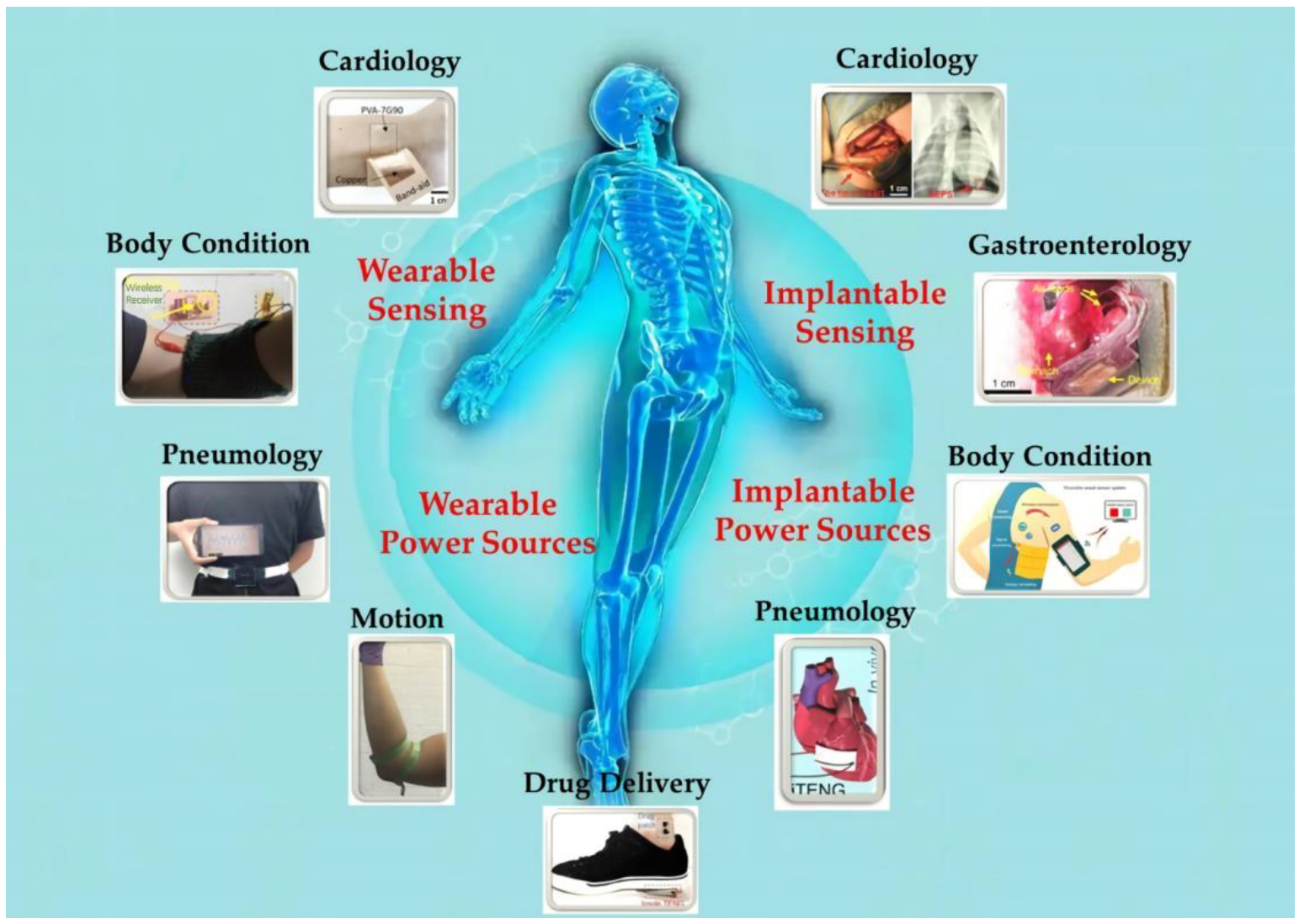
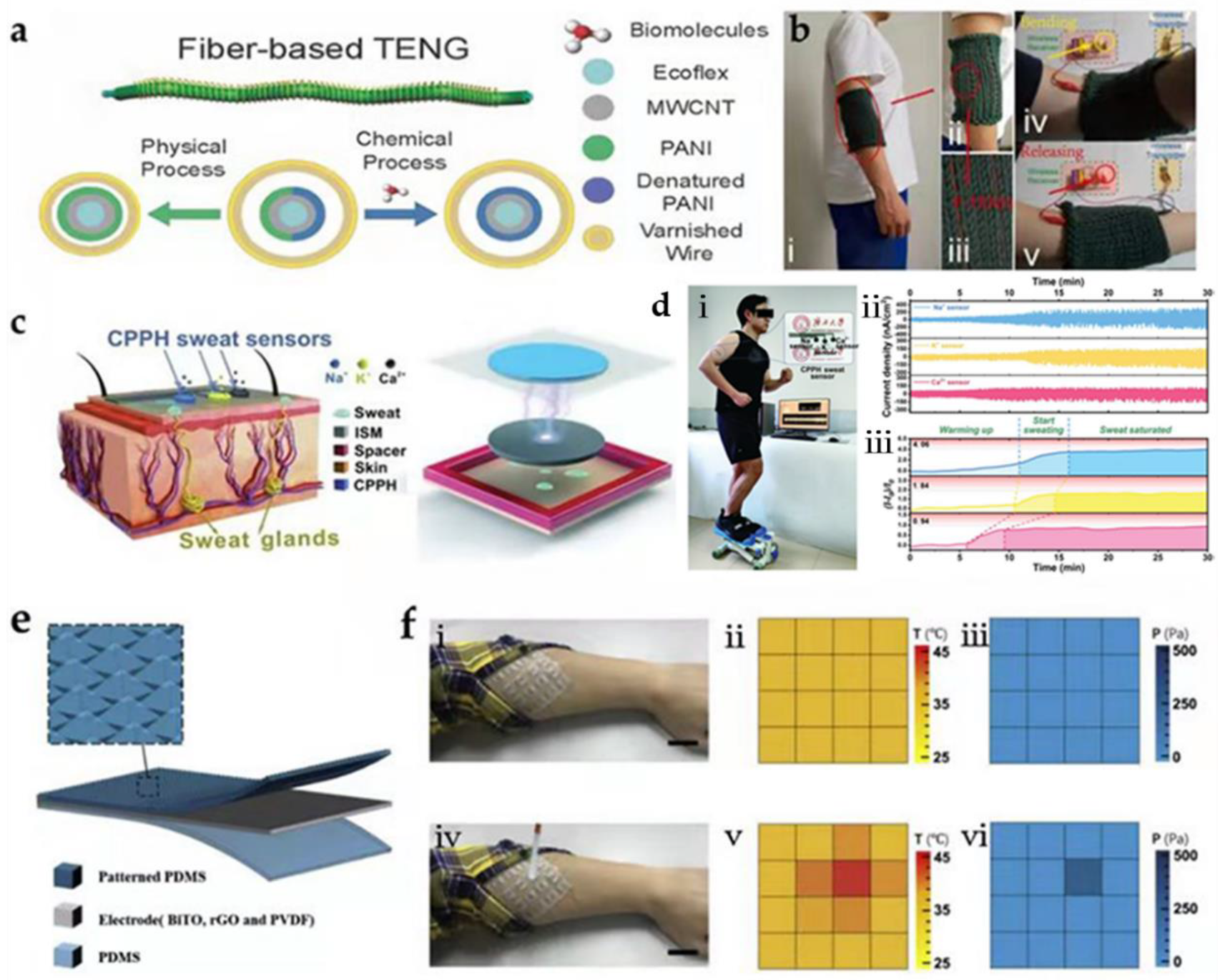
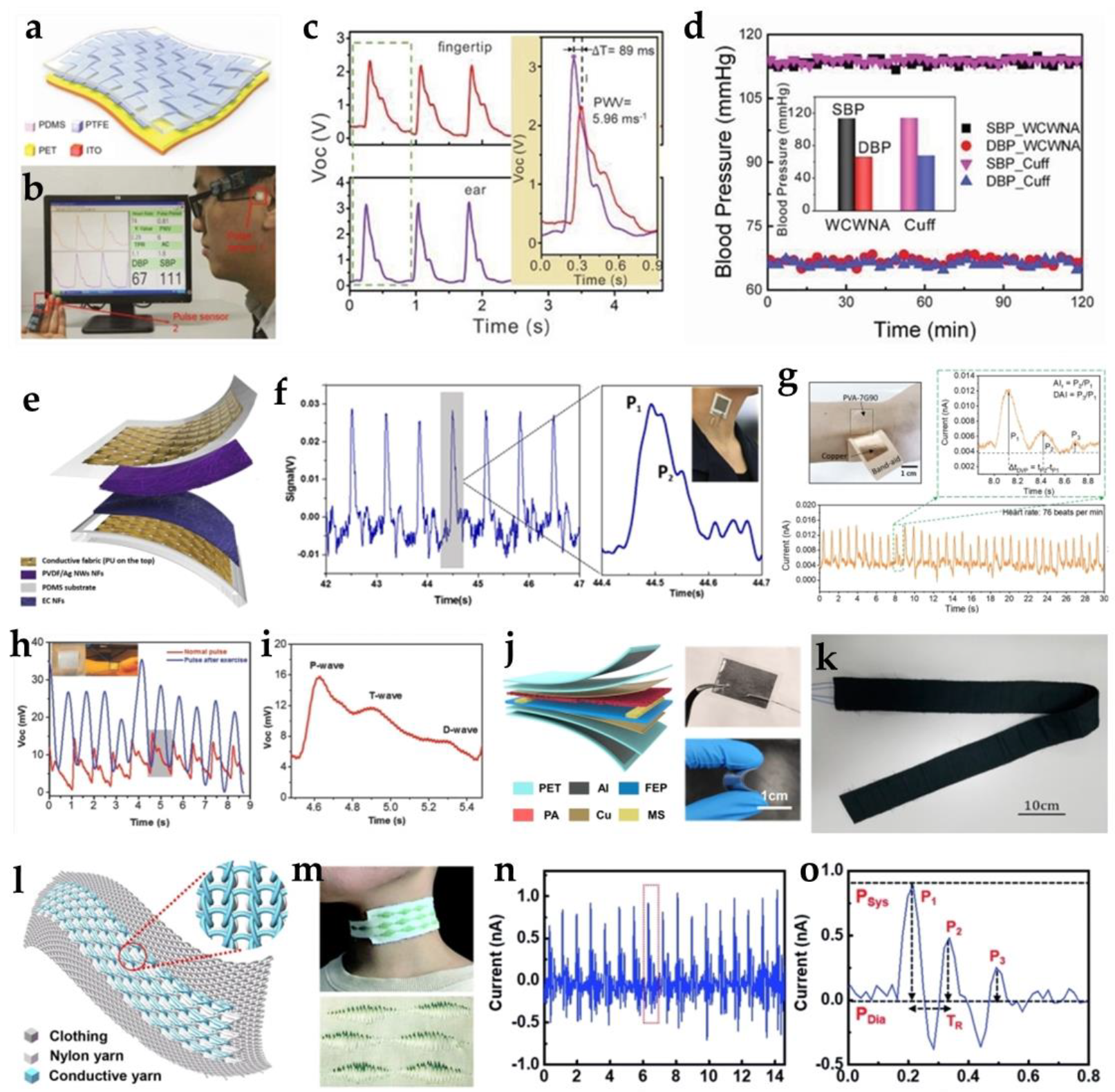
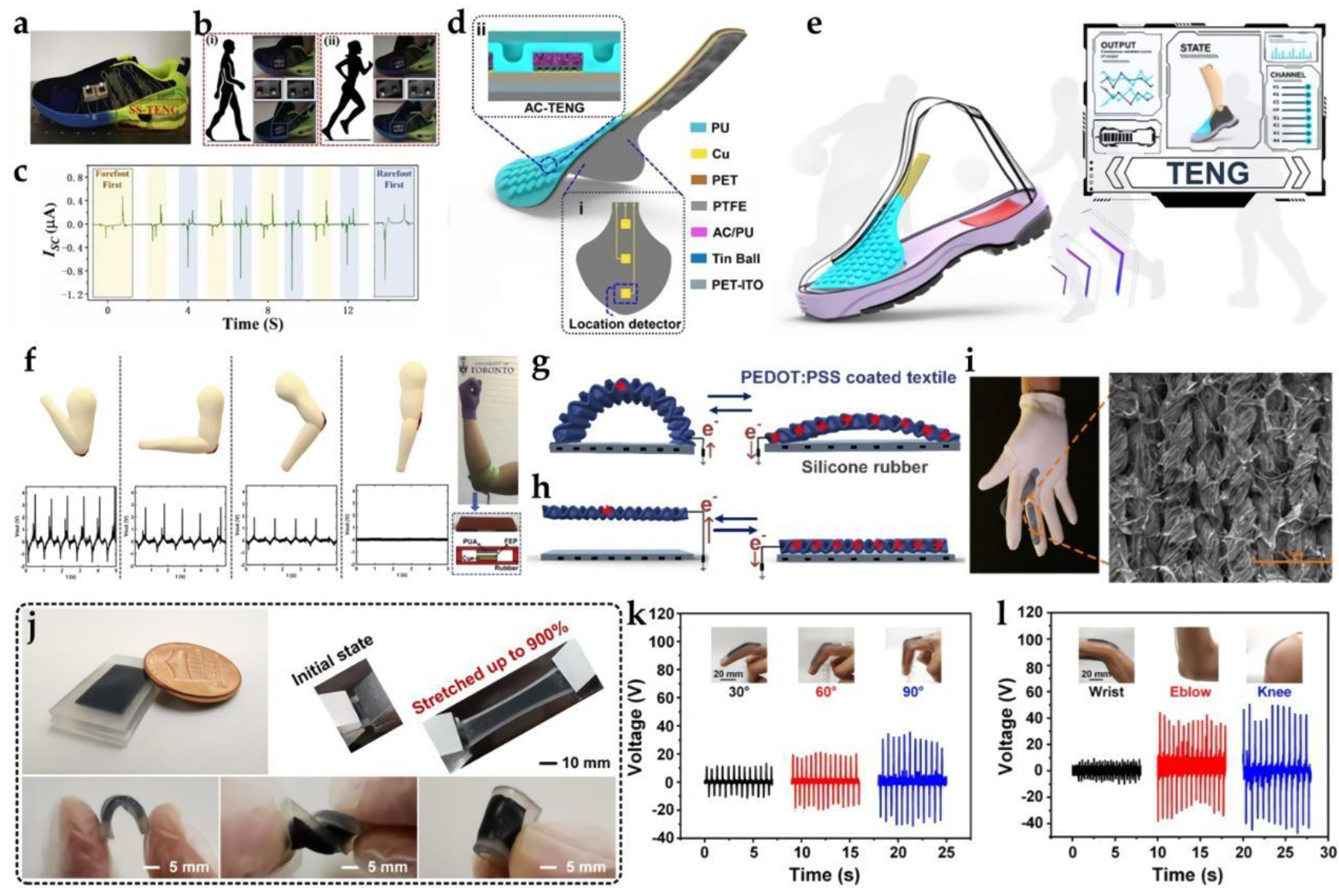
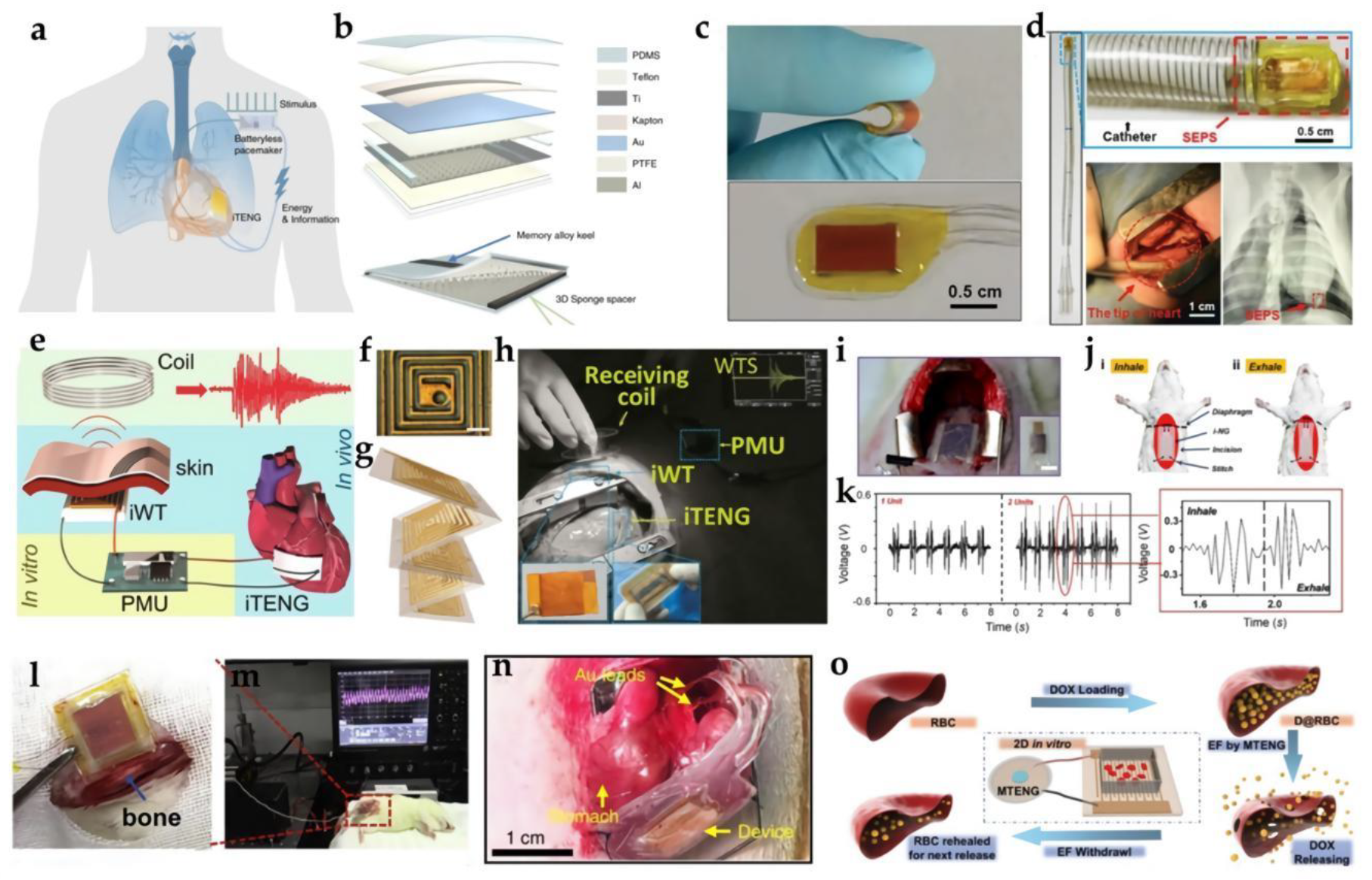
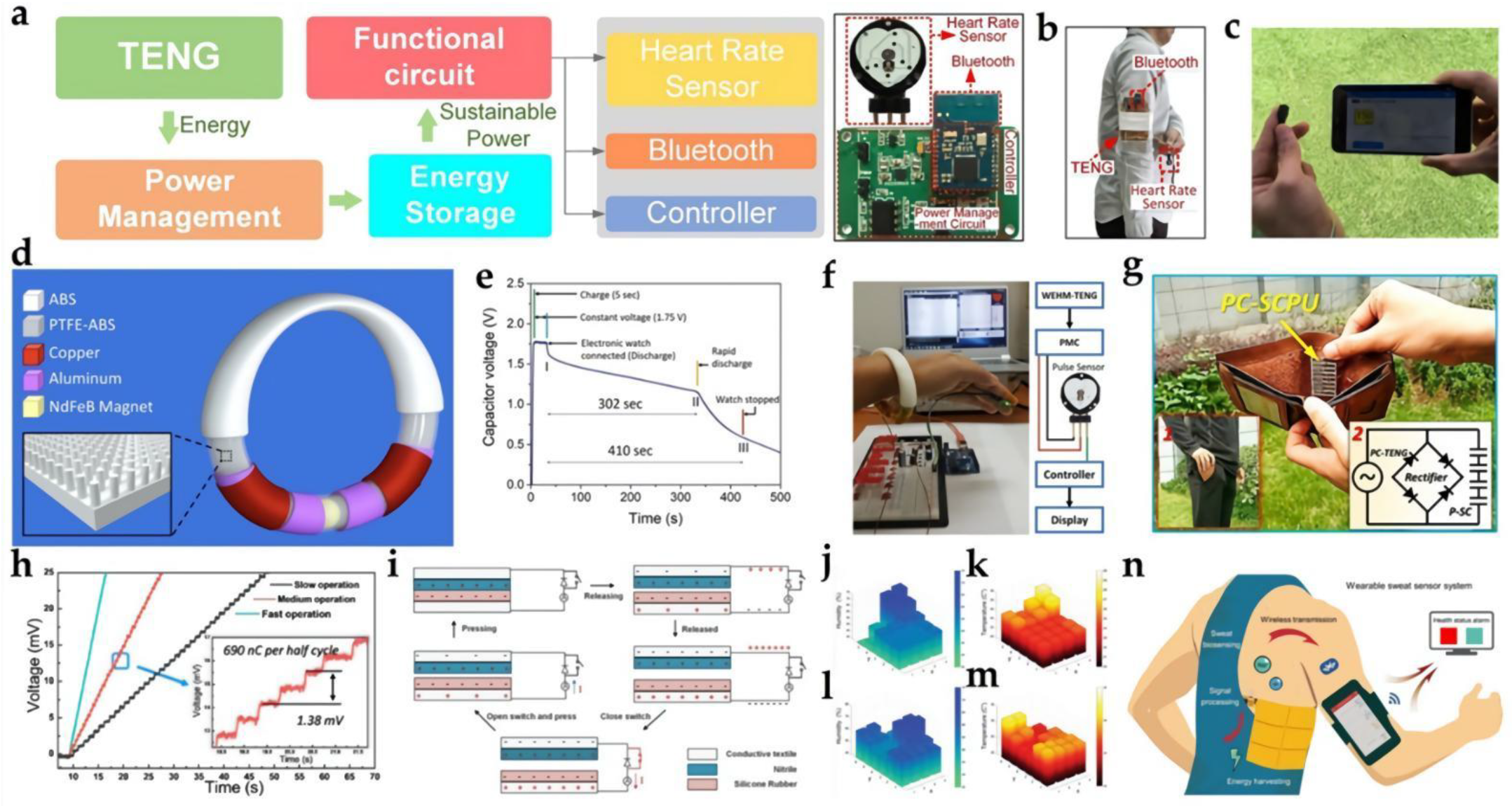
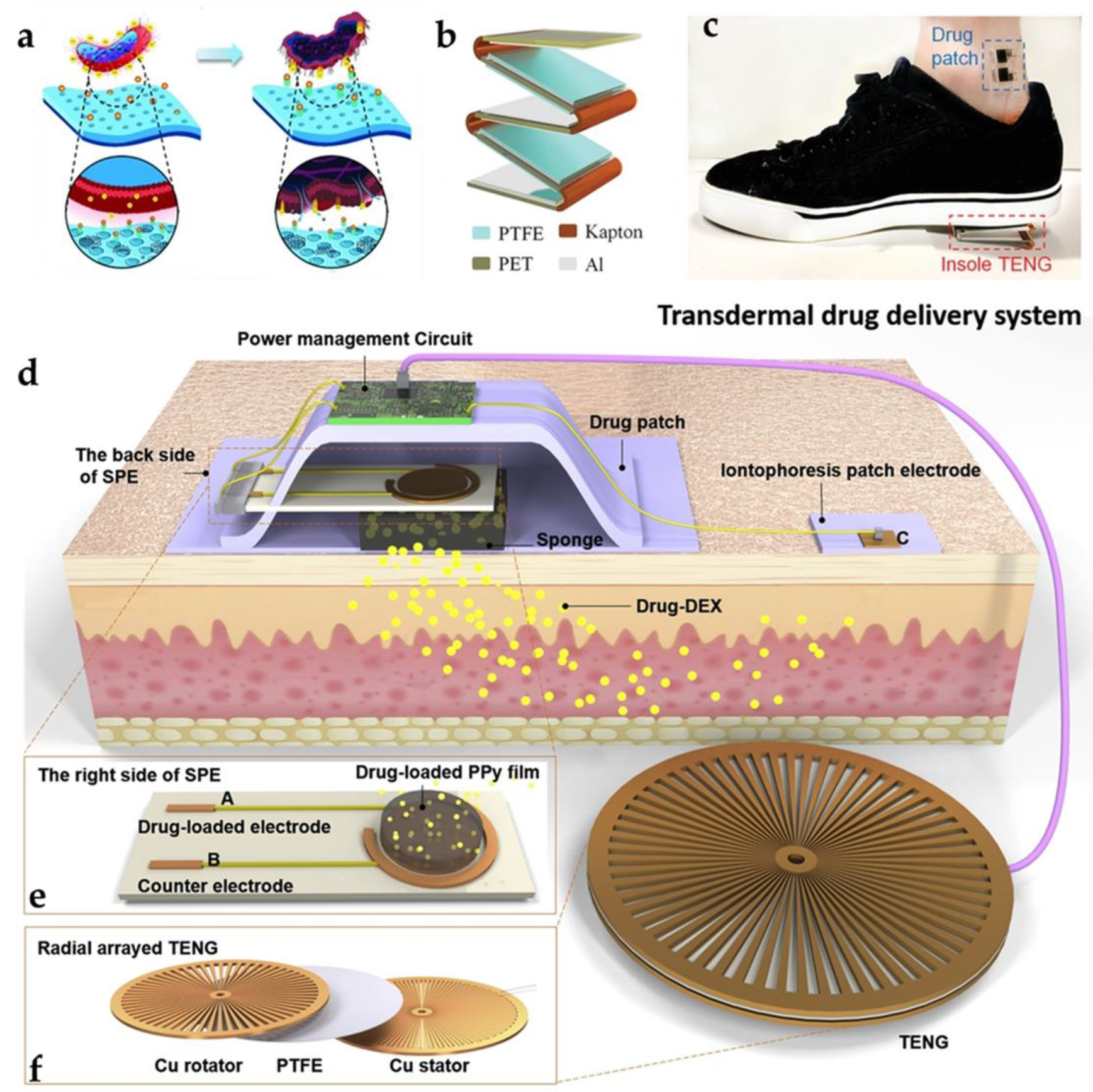
Publisher’s Note: MDPI stays neutral with regard to jurisdictional claims in published maps and institutional affiliations. |
© 2022 by the authors. Licensee MDPI, Basel, Switzerland. This article is an open access article distributed under the terms and conditions of the Creative Commons Attribution (CC BY) license (https://creativecommons.org/licenses/by/4.0/).
Share and Cite
Lu, Y.; Mi, Y.; Wu, T.; Cao, X.; Wang, N. From Triboelectric Nanogenerator to Polymer-Based Biosensor: A Review. Biosensors 2022, 12, 323. https://doi.org/10.3390/bios12050323
Lu Y, Mi Y, Wu T, Cao X, Wang N. From Triboelectric Nanogenerator to Polymer-Based Biosensor: A Review. Biosensors. 2022; 12(5):323. https://doi.org/10.3390/bios12050323
Chicago/Turabian StyleLu, Yin, Yajun Mi, Tong Wu, Xia Cao, and Ning Wang. 2022. "From Triboelectric Nanogenerator to Polymer-Based Biosensor: A Review" Biosensors 12, no. 5: 323. https://doi.org/10.3390/bios12050323





